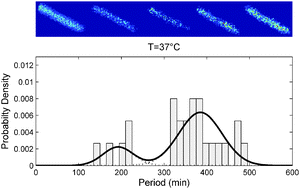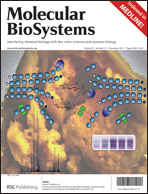Effects of temperature on the dynamics of the LacI-TetR-CI repressilator
Abstract
We studied the behaviour of the repressilator at 28 °C, 30 °C, 33 °C, and 37 °C. From the fluorescence in each cell over time, we determined the period of oscillations, the functionality (fraction of cells exhibiting oscillations) and the robustness (fraction of expected oscillations that occur) of this circuit. We show that the oscillatory dynamics differs with temperature. Functionality is maximized at 30 °C. Robustness decreases beyond 30 °C, as most cells exhibit ‘failed’ oscillations. These failures cause the distribution of periods to become bimodal, with an ‘apparent period’ that is minimal at 30 °C, while the true period decreases with increasing temperature. Based on previous studies, we hypothesized that the failures are due to a loss of functionality of one protein of the repressilator, CI. To test this, we studied the kinetics of a genetic switch, formed by the proteins CI and Cro, whose expression is controlled by PRM and PR, respectively. By probing the activity of PRM by in vivo detection of MS2-GFP tagged RNA, we find that, beyond 30 °C, the production of the CI-coding RNA changes from sub-Poissonian to super-Poissonian. Given this, we suggest that the decrease in efficiency of CI as a repressor with temperature hinders the robustness of the repressilator beyond 30 °C. We conclude that the repressilator is sensitive but not robust to temperature. Replacing CI for a less temperature-dependent protein should enhance robustness.


 Please wait while we load your content...
Please wait while we load your content...